Rajasthan is the land of the Maharajas, an
exotic and colourful home to the legendary warriors of yore, famous for
their gallantry, chivalry, revelry and romance. Its kingdoms redolent with
imposing forts, ethereal palaces, boisterous bazaars, vibrant people,
timeless traditions and centuries of art and culture. Each of its cities has
a unique character and a different colour, its capital Jaipur has the
ditinction of being pink, also considered the colour of hospitality.
Rajasthan Fact File
| Location : |
North west India |
| Area |
342000 Sq Km |
| Population |
44006000 (1991 census) |
| Capital |
Jaipur |
| Language |
Rajasthani, Marwari , Hindi and some English |
| Religion |
Hinduism, Jainism, Islam |
| Currency |
Indian Rupee |
| Climate |
Desert type |
| » Summer |
April - November |
| » Monsoon |
July - September |
| » Winter |
December - March |
Capital of Rajasthan
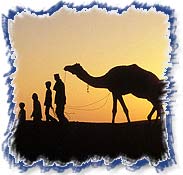
The
Pink City of India, the royal capital of Rajasthan, Jaipur was built by
Maharaja Sawai Jai Singh in 1727 AD. The ancient heart of this regal city
still beats in its fairy tale palaces, its magnificent fortresses perched on
barren hills, and in the broad avenues that provide a superb transport
network throughtout the city.
Soak in the medieval flavour of this city by exploring its many monuments,
go on a camel safari to explore unending stretches of the Thar desert ,
enjoy the cool evenings boating at the Ramgarh lake or linger in its
boisterous bazaars, laden with handicrafts, handloom, jewelery, bandhani,
block print, blankets and trinkets.
History of Rajasthan
The panoramic landscape of Rajasthan has been a silent witness to some of
the most intense battles in history, tragic seiges, astounding victories,
the unearthly valour of fine-cheeked Rajputs, charging to their deaths in
ash and saffron. Dedicated Maharanis committing jauhar by the thousands and
its forts and palaces that have lived on to tell the tale.
Once ruled by the Mauryan empire, Rajasthan became the stronghold of the
Rajput clans in 700 B.C. Around the 12th century parts of Rajasthan were
occupied by Muslim rulers but it was only in the early18th century under
Mughal emperor Akbar's rule that all of Rajasthan was united into one
province. After the decline of the Mughal rulers the Marathas penetrated
into Rajasthan. As a legacy of this back-and-forth rulership of the province
it has a rich culture and architectural heritage blending toghether Mughal,
Hindu and Jain influences.
The People : 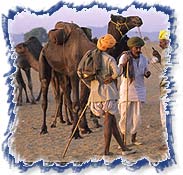
Rajasthan is the region of the proud Rajputs, their valour and chivalry now
a part of legend. They are of Scythian descent- a stock which moved out from
the Caucasus in Central Asia towards the Indus Valley on the one side and
the Germanic parts of Europe on the other.
What meets the eye when travelling through Rajasthan though are dusky,
lissom Rajasthani women with sparkling, kohl-limned eyes, adorned with
silver jewellery and thick, bone bangles worn way above the elbows. They
sport backless cholis, generously pleated long skirts rich in mirror work
and embroidery. A long odhni or head covering flowing gaily behind them
completes the picture of ethnic allure. They smile with a winsome charm as
they sway past with several terracotta pots casually poised on their heads.
The men, without exception, sport colourful, flamboyantly styled turbans.
Their swarthy faces flaunt large mustachios, displaying careful grooming and
obvious pride. In rural Rajasthan, a moustache is an indication of manhood,
virility and macho power.
Along with the Rajputs this land is also inhabited by Muslims and Brahmins.
The Bhils and Meenas are two of the biggest tribes to be found here.
The official language is Hindi
Culture of Rajasthan :
The hard life of the desert dwellers made them seek means of making life
more pleasant, this gave rise to a vibrant culture that still lives on.
Fairs and festivals, dance and music, colours, costumes and wandering
balladeers truly make it a setting difficult not to fall in love with. The
royalty also aided and abeted creative arts and exquisite miniature
paintings, precious manuscripts and craftily designed wares can be seen in
their palaces and museums.
Districts of Rajasthan
| District (for more info. click the cities below) |
Area (Sq. Km) |
| » Ajmer |
8,481 |
| » Alwar |
8,380 |
| » Banswara |
5,037 |
| » Baran |
6,955 |
| » Barmer |
28,387 |
| » Bharatpur
|
5,066 |
| » Bhilwara |
10,455 |
| » Bikaner |
27,244 |
| » Bundi |
5,550 |
| » Chittorgarh |
10,856 |
| » Churu |
16,830 |
| » Dausa |
2,950 |
| » Dholpur |
3,084 |
| » Dungarpur |
3,770 |
| » Dungarpur |
3,770 |
| » Hanumangarh |
12,645 |
| » Jaipur |
14,068 |
| » Jaisalmer |
38, 401 |
| » Jalor |
10,640 |
| » Jhalawar |
6,219 |
| » Jhunjhunu |
5,928 |
| »
Jodhpur |
22,850 |
| » Karauli |
5530 |
| » Kota |
12,436 |
| » Nagaur |
17,718 |
| » Pali |
12,387 |
| » Rajsamand |
4,768 |
| » Sawai Madhopur |
10,527 |
| » Sikar |
7,732 |
| » Sirohi |
5,136 |
| » Sri Ganganagar |
7,984 |
| » Tonk |
7,194 |
Rajasthan in General
1 . Cuisine of Rajasthan
In this desert climate not much could be grown in the way of crops but you
are in for a real treat when it comes to Rajasthani cuisine. The inventive
chefs of yesteryears kings have created some mouthwatering delicacies. High
on the must-sample list are the dal bati churma, gatta ki sabzi, mangodi,
bajra ki roti, mirch pakodi and varoius chutneys and papads. The smoked
Rajasthani kebab - sule is bare-be-cued in about a dozen different ways and
is a non vegetarian delicacy. Besides, each region is distinguished by its
popular sweet - Mawa Kachori from Jodhpur, Malpuas from Pushkar, Rasogullas
from Bikaner, Ghevar from Jaipur..to name a few.
2. Climate in Rajasthan
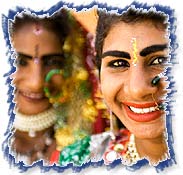
Given
its varied topography the climate varies throughout Rajasthan. The west is
relatively dry and infertile; it includes some of the Thar Desert, also
known as the Great Indian Desert. In the southwestern part of the state, the
land is wetter, hilly and more fertile. On average winter temperatures range
from 8° to 28° C (46° to 82° F) and summer temperatures
range from 25° to 46° C (77° to 115° F). Rains falls
from July through September during the monsoon season. The best time to
travel to Rajasthan is during the winter, which extends from December to
March. January is the coolest month of the year
3. Customs and Manners
Rajasthan is an ancient land with a diverse culture and many timeless
traditions still thrive in its heartland. The aarti, tilak, namaskar and use
of garlands is a common welcome for important guests.
Madana the Rajasthani art of decorating courtyards and prayer halls, using
coloured powders has also been kept alive.
4. Dress
Clothes in kaleidoscopic colours complemented by ornate jewelery is a
trademark of the Rajasthani people.
The common dress of the women constitutes a sari or odhani, choli, ghaghra
or lahanga. Besides, the women of high status and ranks wear dupatta and
patka.
The use of chappals or sandals or jutees is also common but ladies of high
families use coloured sandals studded with gold threads and stars.
Turban, the head dress of Rajasthani men, is a differential pattern, of
each geographical region designed to suit terrain and climatic influence.
All over Rajasthan, the bandhni, the tie-and-dye sari and turban reign
supreme.
5. Dances of Rajasthan
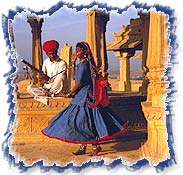
The
dances of Rajasthan seem to have originated from the depths of the desert
and the hearts of its people. Women dancers pirouette gracefully and their
Ghaghras (skirt) flare out in a blaze of color and movement. Regal men in
fulsome, gathered white ankle-length skirts and brilliant turbans swirl and
execute intricate choreographic patterns. Most popular among these sensuous
and riveting dances are Ghoomar, Bhavai, Kachhi Ghodi, Chari, Kalbeliya,
Gair, Kathputli and Terahtaali.
6. Music of Rajasthan
The rythms and tunes of Rajasthani folk music seem akin to the songs of its
shifting sands. Maand is the original Rajasthani music that flourished in
its courts. Among the professional folk musicians the Bhopas (singing
priests), Nats, Bhat puppeteers, Kalbelias and Kanjars made some vital
contributions to Rajasthani music .
7. Musical instruments of Rajasthan
To this day Rajasthani musicians use many unsophisticated indegenous
instruments that produce strangely mesmeric sounds - such as the bankia,
flutes called algoza, the hypnotic Jewish harp or morchhang, the stringed
instrument with a tinkling cluster of bells called the ravanhatta and the
earthen pitcher or matka which is turned in the hands with amazing dexterity
and is used as a percussion instrument.
8. Fairs and Festivals of Rajasthan
Fairs and festivals are an integral part of the life of the people of
Rajasthan, tribals and locals can be seen racing camels, buying and selling
elephants, hawking wares and competing and celebrating together. Apart from
all the usual Hindu and Muslim festivals Rajasthan has a number of festivals
of its own. Choose from the Camel festival at Bikaner in January, Nagaur
Fair in January - February; Desert Festival of Jaisalmer in February;
Elephant Festival Jaipur; Gangaur Festival celebrated all over the state in
March - April; Mewar Festival in Udaipur; Urs in Ajmer Sharif; Teej in the
months of August; Marwar Festival at Jodhpur in October; and Camel and
Cattle Fair of Pushkar in November.
9. Geography
Located in the nort-west of India it is an easily accessible destination.
India's oldest mountain chain , the Aravalis runs across this land and is
responsible for its hauntingly beautiful landscape as it cuts off the
western part of this land from the Monsoon winds, turning it into an arid
desert and the east into a more fertile land with dense forests.
10. Handicrafts
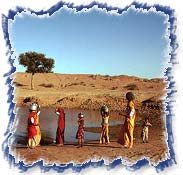
Rajasthan's
dazzling display of handicrafts, and the profusion of vibrantly coloured
fabrics, leaves the visitor gasping in wonder. Its lively, crowded markets
offer a wide range of local products, and are favourite haunts of visiting
shoppers. While times have changed, bazaar protocol has not, and
good-humoured, lively bargaining is an important part of the exuberance.
If you are interested in a superb deal, search for curio shops selling old
silver jewellery. Other popular items on display are tie-and-dye fabrics,
embroidered jutis or slippers in suede, camel skin, and velvet, the
beautiful and justly famous lacquer bangles, antiques, carpets and
Rajasthani puppets.
11. Languages
The principal languages are Hindi and Rajasthani
12. Wild Life Game Sanctuaries
Shikar was a popular sport among the royalty in olden times. Many of
Rajasthan's forests are still teeming with ferocious wildlife and have been
converted into sanctuaries. These include the Keoladeo Ghana National Park
of Bharatpur, one of the finest bird parks in the world. The Ranthambore
National Park which is home to the majestic Indian tiger. The Sariska
National Park which is a natural habitat for a wide range of wildlife and is
best known for the tigers.
The Desert National Park of Rajasthan comprises of the vast tracts of
desert sands and a unique variety of wildlife species supported by the
desert ecosystem.
Amongst the smaller sanctuaries and wildlife reserves in Rajasthan are the
Bhensrodgarh, Darrah, Jaisamand, Kumbalgarh, Mount Abu, Chambal, Sitamata
and Talchappar.
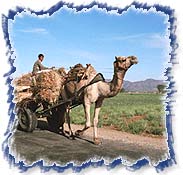 Occupation in Rajasthan :
Occupation in Rajasthan :
The main occupation of the people in the desert is agriculture and animal
husbandry In this handicraft rich province many people are employed in
traditional occupations of wood carving, block printing and pottery also.
Occupational groups of nomadic hunters, trappers, blacksmiths, basket
weavers and entertainers like puppeteers, acrobats, fortune-tellers, singers
and dancers share a symbiotic relationship with the settled people.
Major Attractions of Rajasthan
Desert
Safari in Rajasthan
Ajmer sharif
Amber Fort - Jaipur
City Palace - Udaipur
Eklingji Temple
Fateh Sagar Lake - Udaipur
Gadi Sagar Lake - Jaisalmer
Hawa Mahal - Jaipur
Jain Temples
Jaisalmer Fort
Jantar Mantar - Jaipur
Jodhpur Fort
City Palace - Udaipur
|


 The
Pink City of India, the royal capital of Rajasthan, Jaipur was built by
Maharaja Sawai Jai Singh in 1727 AD. The ancient heart of this regal city
still beats in its fairy tale palaces, its magnificent fortresses perched on
barren hills, and in the broad avenues that provide a superb transport
network throughtout the city.
The
Pink City of India, the royal capital of Rajasthan, Jaipur was built by
Maharaja Sawai Jai Singh in 1727 AD. The ancient heart of this regal city
still beats in its fairy tale palaces, its magnificent fortresses perched on
barren hills, and in the broad avenues that provide a superb transport
network throughtout the city.
 Given
its varied topography the climate varies throughout Rajasthan. The west is
relatively dry and infertile; it includes some of the Thar Desert, also
known as the Great Indian Desert. In the southwestern part of the state, the
land is wetter, hilly and more fertile. On average winter temperatures range
from 8° to 28° C (46° to 82° F) and summer temperatures
range from 25° to 46° C (77° to 115° F). Rains falls
from July through September during the monsoon season. The best time to
travel to Rajasthan is during the winter, which extends from December to
March. January is the coolest month of the year
Given
its varied topography the climate varies throughout Rajasthan. The west is
relatively dry and infertile; it includes some of the Thar Desert, also
known as the Great Indian Desert. In the southwestern part of the state, the
land is wetter, hilly and more fertile. On average winter temperatures range
from 8° to 28° C (46° to 82° F) and summer temperatures
range from 25° to 46° C (77° to 115° F). Rains falls
from July through September during the monsoon season. The best time to
travel to Rajasthan is during the winter, which extends from December to
March. January is the coolest month of the year  The
dances of Rajasthan seem to have originated from the depths of the desert
and the hearts of its people. Women dancers pirouette gracefully and their
Ghaghras (skirt) flare out in a blaze of color and movement. Regal men in
fulsome, gathered white ankle-length skirts and brilliant turbans swirl and
execute intricate choreographic patterns. Most popular among these sensuous
and riveting dances are Ghoomar, Bhavai, Kachhi Ghodi, Chari, Kalbeliya,
Gair, Kathputli and Terahtaali.
The
dances of Rajasthan seem to have originated from the depths of the desert
and the hearts of its people. Women dancers pirouette gracefully and their
Ghaghras (skirt) flare out in a blaze of color and movement. Regal men in
fulsome, gathered white ankle-length skirts and brilliant turbans swirl and
execute intricate choreographic patterns. Most popular among these sensuous
and riveting dances are Ghoomar, Bhavai, Kachhi Ghodi, Chari, Kalbeliya,
Gair, Kathputli and Terahtaali.  Rajasthan's
dazzling display of handicrafts, and the profusion of vibrantly coloured
fabrics, leaves the visitor gasping in wonder. Its lively, crowded markets
offer a wide range of local products, and are favourite haunts of visiting
shoppers. While times have changed, bazaar protocol has not, and
good-humoured, lively bargaining is an important part of the exuberance.
Rajasthan's
dazzling display of handicrafts, and the profusion of vibrantly coloured
fabrics, leaves the visitor gasping in wonder. Its lively, crowded markets
offer a wide range of local products, and are favourite haunts of visiting
shoppers. While times have changed, bazaar protocol has not, and
good-humoured, lively bargaining is an important part of the exuberance.  Occupation in Rajasthan :
Occupation in Rajasthan : 